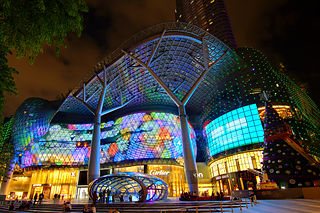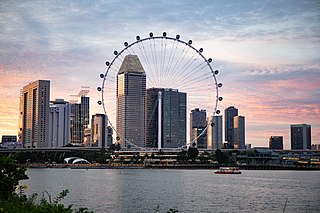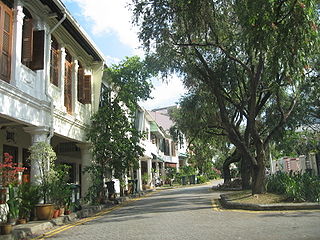
Orchard Road, often known colloquially as simply Orchard, is a major 2.5 km (1.6 mi)–long road in the Central Area of Singapore. A famous tourist attraction, it is an upscale shopping area, with numerous internationally renowned department stores, restaurants and coffeehouses located in its vicinity.

Bishan, also known as Peck San, Bishan New Town or Bishan Town, is a planning area and matured residential town located at the northernmost portion of the Central Region of Singapore. Statistically, the area is ranked the 38th biggest in terms of geographical size and the 22nd most populated planning area in the country. It is located at the most Central point of Singapore, and it comprises Upper Thomson, Marymount, Shunfu, Sin Ming, Bishan North and Bishan East. There are also many private residential properties in Bishan. Bishan is ranked 15th in terms of population density. Apart from its boundary with the Central Water Catchment in the west, Bishan borders three other planning areas: Ang Mo Kio to the north, Toa Payoh to the south, and Serangoon to the east.

Ngee Ann City is a shopping and commercial centre located on Orchard Road, Singapore. The S$520 million building was officially opened on 21 September 1993 by then-Prime Minister Goh Chok Tong.

Lau Pa Sat, also known as Telok Ayer Market, is a historic building located within the Downtown Core in the Central Area of Singapore. It was first built in 1824 as a fish market on the waterfront serving the people of early colonial Singapore and rebuilt in 1838. It was then relocated and rebuilt at the present location in 1894. It is currently a food court with stalls selling a variety of local cuisine.

The MacDonald House is a prominent building and monument in Singapore, located at Orchard Road in the Museum Planning Area, within the Central Area of the country. Built in 1949, it was the first building to be fully air-conditioned in Southeast Asia. Located a short distance from the Istana, it was the last remaining office building in facing brick in the central area.

This article shows the notable future developments in Singapore. Most of them are currently under construction with most to be completed within the next five years.

The Old National Library Building was a demolished historical library building at Stamford Road in the Museum Planning Area of Singapore. Originally completed in 1960, the library building was a national icon for many Singaporeans. Despite a huge groundswell of public dissent, the library was closed on 31 March 2004, and was demolished in July that year to make way for the construction of the Fort Canning Tunnel to ease road traffic to the city. The controversy surrounding the building's demise has been credited for sparking greater awareness of local cultural roots and an unprecedented wave in favour of heritage conservation among Singaporeans.

The Fullerton Hotel Singapore is a five-star luxury hotel located near the mouth of the Singapore River, in the Downtown Core of the Central Area, Singapore. It was originally known as the Fullerton Building, and also as the General Post Office Building. The address is 1 Fullerton Square. The Fullerton Building was named after Robert Fullerton, the first Governor of the Straits Settlements (1826–1829). Commissioned in 1924 as part of the British colony's centennial celebrations, the building was designed as an office building by Major P.H. Keys of Keys & Dowdeswell, a Shanghai firm of architects, which won the project through an architectural design competition. The architectural firm also designed the Capitol Theatre, its adjoined Capitol Building and the Singapore General Hospital. In 2015, it was designated as a national monument of Singapore.
Swan & Maclaren Architects is a Singaporean architectural and industrial design firm. One of the oldest architectural firms in the country, it was formerly known as Swan & Maclaren and Swan & Lermit, and was one of the most prominent architectural firms in Singapore when it was a crown colony during the early 20th century. The firm has designed numerous iconic heritage buildings in Singapore as well as Malaysia.

Stamford House is a historic building located at the corner of the junction of Stamford Road and Hill Street, in the Downtown Core of Singapore. Originally known as Oranje Building, it formerly housed a shopping mall. The building had since redeveloped along with adjoined Capitol Building and both were reopened as a hotel The Capitol Kempinski Hotel Singapore in October 2018.

The New World Amusement Park was the first of three amusement parks, along with Great World and Gay World, that wooed Malaya and Singapore night crowds from the 1920s to the 1960s. New World was a prominent landmark along Jalan Besar, in modern-day Kallang planning area, as it occupied a large area of 45,000 square feet (4,200 m2) in size. Before the arrival of televisions and radios, it attracted people from all walks of life from labourers to Europeans with its exciting attractions such as striptease, cabaret girls, opera shows and boxing matches during its heyday. Of all the artistes and athletes who have performed at the New World through the years, four have left a lasting impression – striptease queen Rose Chan, wrestler King Kong, strongman Mat Tarzan, and boxer Felix Boy. With the advent of shopping centres, discos and, particularly, television in the ensuing decades, the park business gradually became poor, and it was finally closed for good after being sold to a property developer for redevelopment in 1987.

Orchard Point is a shopping centre in Singapore.

Susan Hendrik 'Henk' van Sitteren (1904–1968) was a Dutch architect in Singapore and Malaysia. His career began when he came to Singapore and landed a position in Keys & Dowdeswell, then a major international architecture firm. It was during this time that Van Sitteren met his future partner, architect Berthel Michael Iversen. The two would later establish Iversen & Van Sitteren Partners - with branches in Ipoh, Penang, Kuala Lumpur & Singapore. The firm was one of the most important in Southeast Asia for establishing a foothold for international style modernism.
The Jurong railway line is a former railway line located in Singapore. Stretching a total of 12 miles (19 km) from Bukit Timah to the Jurong industrial estate, the line consisted of a 9 miles (14 km) main line and three branches. The line was initially planned as part of the Jurong industrial estate by the Singapore government, to connect the industrial estate with Malaya and to facilitate the transfer of goods between Malaya and Jurong. A $6 million loan was given to the Malayan Railway for its construction, which was carried out by the railway and the Economic Development Board, and construction of the line took place between September 1963 and November 1965, with the first train services commencing in the same month. The line was then officially opened on 4 March 1966. However, the line's potential was limited by Singapore's separation from Malaysia in 1965, with 128,000 tons of freight transported on the line in 1974, and the line eventually closed in the 1990s. Portions of the line remain in place, some of which have become popular among explorers and wildlife enthusiasts.

Tanglin Halt is a public housing estate, planning subzone and former industrial estate in Queenstown, Singapore. Most of the older buildings in the estate are set to be demolished by 2024 to make way for redevelopments under the Selective En bloc Redevelopment Scheme. It is the third housing estate to be redeveloped under the scheme.
Amber Mansions was a shopping centre and residential building located at the curve between Orchard Road and Penang Road in what is currently known as Dhoby Ghaut, Singapore. Constructed in the 1920s, the shopping centre was one of the first shopping centres in Singapore.
Commonwealth Avenue Wet Market, also known as Queenstown Market, is a former wet market on Commonwealth Avenue in Queenstown, Singapore. It is the only remaining market designed by the Singapore Improvement Trust.

Malayan Bank Chambers, also known as Maybank Chambers and originally known as the Whiteaway Laidlaw Building or the Whiteaway Laidlaw & Co Building, was a building on Battery Road in Singapore.
The Heeren Building was a building built on the corner of Orchard Road and Cairnhill Road in Singapore in 1931. It was demolished in 1990 due to a road realignment project.
















